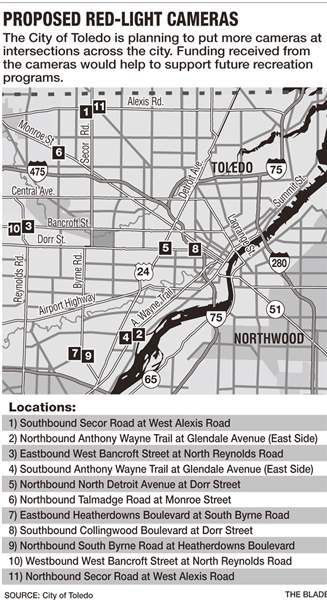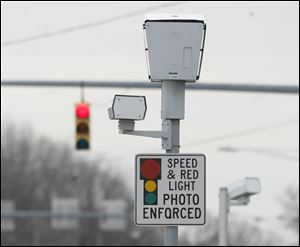
Sites for new red-light cameras set
Intersections near Whitmer High, mall on list
1/30/2012

The planned installations would raise the city’s total of fixed red-light cameras to 43.
A city of Toledo proposal to install 11 additional red light cameras across the city targets busy intersections close to the Westfield Franklin Park mall, the Toledo Zoo, and Whitmer High School.
In all, seven intersections would be slated for new red light cameras, some with the devices positioned in two locations, according to a list released by the city.
The new cameras are planned for:
- The southbound and northbound lanes of Secor Road at West Alexis Road, a congested intersection near Whitmer High School;
- The northbound and southbound lanes of the Anthony Wayne Trail at Glendale Avenue southwest of the Toledo Zoo;
- The eastbound and westbound lanes of West Bancroft Street at North Reynolds Road;
- The eastbound and northbound lanes at Heatherdowns Boulevard at South Byrne Road;
- Northbound North Detroit Avenue at Dorr Street;
- Northbound Talmadge Road at Monroe Street, close to Westfield Franklin Park mall;
- Southbound Collingwood Boulevard at Dorr Street.
The city hopes the red-light enforcement cameras, if approved by council and installed by April, will generate $320,000 to help fund public recreation programs which could otherwise be shut down.
The addition would bring the total number of fixed red-light cameras in Toledo to 43. The city also has a mobile camera attached to a marked van used to catch speeders in school zones.
Finance Director Patrick McLean said the city selected the new intersections with the help of the Arizona-based company American Traffic Solutions.
The firm used a computer program to analyze traffic volumes and patterns across Toledo to determine intersections at which red light violations are most likely to occur, he said.
The city has yet to choose a supplier for the actual cameras, he added. The devices already in place were supplied by Redflex Traffic Systems Inc. of California.
Mr. McLean and other officials have touted the proposed new cameras as a way not only to raise needed funds, but to enhance public safety by reducing traffic accidents.
“These things have proved themselves to be effective at the intersections where they’re installed,” Mr. McLean said.

The program has been a money-maker for both the city and Redflex, which takes in about half of the fines collected from violations, Mr. McLean said.
For the city, the program brought in just over $1 million in 2011, and $787,839 the year before.
The city also has attempted to crack down on scofflaws by allowing police to immobilize or tow vehicles whose owners have multiple fines unpaid for 21 days or more, although Mr. McLean said those efforts have not been particularly successful.
The new cameras would catch red light violations only, not speeding, the director said.
Drivers face $120 fines for going through a red light and may be assessed a $25 late fee if the penalty is not paid or appealed within 21 days.
Camera-based citations are civil, so no driver’s license points are assessed to violators the cameras catch.
Red-light cameras have been controversial since their introduction in the 1990s. Critics argue the cameras are a violation of privacy and serve mainly to boost state and local governments’ coffers. Proponents counter the cameras help curb traffic violations that cause accidents, thus creating safer roads.
Three of the existing cameras are located in heavy traffic areas near Westfield Franklin Park: southbound Talmadge Road at Sylvania Avenue; eastbound Monroe Street near Secor Road, and northbound Secor at Monroe.
Lt. Jeff Sulewski, head of the Toledo Police Department’s traffic section, said the cameras do encourage people to drive more carefully.
“I think they serve a good purpose, that is when they are installed and people see the signs … hopefully they’re watching their driving,” he said. “Anything that gets people to drive more safely, we’re all for that.”
A nationwide study the Insurance Institute for Highway Safety issued early in 2011 found Toledo’s red-light cameras reduced fatal crashes attributable to red-light runners by 39 percent, albeit with a relatively small sample size compared to other cities.
Toledo city councilmen, who are slated to vote on the red-light camera addition Tuesday as part of the overall 2012 budget, have mostly expressed support for the program.
“If it will keep accidents down, then fantastic. I think we’ve probably come to accept the cameras as part of our landscape,” councilman Tom Waniewski said.
Councilman Mike Craig also applauded the initiative, although he sympathized with some of the public’s dislike for the cameras.
“I’m not in favor of them as a citizen, and as a private citizen it’s for very selfish reasons,” Mr. Craig said. “But as a councilman and someone concerned about public safety, I think they do a terrific job.”
Contact Claudia Boyd-Barrett cbarrett@theblade.com or 419-724-6272